Easy Way toadd Weight to Buffer in Ar
- Overgassed AR15
- An overgassed AR15 is when the gun cycles too fast due to an imbalance of too much gas pressure acting on the mass of the bolt carrier group, buffer weights and the tension of the buffer spring. Gas operated firearms like the AR15 redirect some of the high pressure gases released by firing the gun to cycle the bolt in order to automatically remove the spent cartridge and load a new cartridge. If too much of that gas is redirected to cycle the action, then the firearm is said to be overgassed.
- Symptoms of an Overgassed AR15
- The most obvious sign of an overgassed AR is that the firearm will fail to properly cycle, aka jam. You may get double feeds where the firearm ends up with new cartridge(s) stuck in the action. You may also notice that spent cases eject noticeably toward the front of the firearm, instead of out the side and slightly to the rear. Overgassed firearms will have greater than normal felt recoil. Over time, an overgassed firearm will show signs of premature wear and parts breakage.
- Gun jams
- Excessive recoil
- Premature wear & parts breakage
- Spent cartridges eject toward the front of the rifle, instead of sideways and slightly to the rear.
- How to fix an overgassed AR15
-
- Get heavier AR15 buffer weights. This is the simplest and most reliable solution. Most carbines come with a light weight buffer. Switching to an h2 or h3 carbine buffer will increase the mass of the reciprocating assembly, thus counteracting the gas pressure more effectively. Getting a heavier buffer is the most reliable solution because it doesn't add any failure points.
- Get a heavier buffer spring. This is another solution that doesn't rely on any new parts and should be reliable. But, in my opinion, it doesn't mitigate recoil as well as an h2 or h3 buffer so it's not my preferred method.
- Get an adjustable gas block. Adjustable gas blocks are the most precise solution if maximum recoil reduction is desired. But, I don't prefer adjustable gas blocks because they are a frequent source of unreliability in AR15s. Over time, the moving parts in AR15 adjustable gas blocks become frozen in place due to the extreme heat and carbon fouling present in burning gun powder. The only time I'd personally choose an adjustable gas block for an AR15 would be for a dedicated competition rifle.
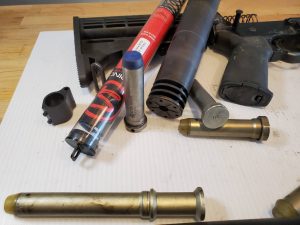
While AR-15 rifles are very reliable, there are times when an "overgassed" AR15 can have some reliability issues. The AR15 is a gas-operated rifle, meaning that some of the explosive gas pressure that propels the bullet is redirected into the back of the gun, where it is used to eject the spent shell case and load the next round. Overgassing is when this gas-operated system gets too much gas pressure, resulting in the gas-operated system cycling too fast. Slightly high gas pressure can help cycle a dirty gun. But over time, running an overgassed AR15 can result in premature parts breakage and malfunctions. Severely overgassed rifles can cause the gun to jam, malfunction and have heavier-than-normal recoil.
After some early teething problems in the Vietnam era, the AR-15 and its military equivalents (M16, M4 etc) matured to become the most prolific rifle platform in the United States and many other countries. Military and civilians alike prefer the AR-15/M16 because of its simplicity, accuracy, reliability and ease of customization. Generally, a factory-built rifle or carbine will function very well right out of the box, but in some cases you may encounter one that is overgassed. The modularity and wide parts availability makes home-brew AR variants very popular, with many novice shooters successfully building their first gun from online parts kits and purchasing a receiver.
These home-built rifles have a higher success rate than may be assumed due to the relatively simple process of building an AR. That said, home builds are more likely to have a few issues that need ironed out. Usually, problems with home builds are easily solved with a few adjustments or alterations. While problems are statistically rare in factory-built guns, if you're doing three-gun, tactical training or run a silencer/suppressor, you may be more likely to experience some issues.
PROTIP: If you experience problems with your AR15, the first thing to check is your magazines (some people incorrectly call it a "clip"). Be careful not to force too many rounds into a magazine because this can dent the cartridges and lead to jamming. When the magazine is full, there should be almost enough room for one more round. The rifle needs this little bit of space to clear the bolt properly. The most reliable magazines are currently MagPul pmags followed by GI metal magazines. Stay away from Promag, these are a lower-quality knock-off. Consider marking your magazines and keep track if a particular magazine makes the gun jam. If you're having trouble releasing or retaining magazines, check this video out.
Aside from faulty/overloaded magazines and an out-of-spec magazine release, an overgassed rifle is likely the most common cause of AR15 malfunctions, especially home-built AR15 jams, double-feeding and similar malfunctions. So, let's get into fixing it.
How to fix an Overgassed AR15
- Unusually harsh recoil
- Shell casings eject more toward the front of the rifle
- Jamming, malfunctions
- Visible damage to AR15 buffer assembly
- Undergassed is the opposite, and you'll see failure to eject spent cartridges, the bolt may not lock back when the magazine is empty and/or spent cases will be ejected more toward the rear of the rifle
Signs of an Overgassed AR15
- The AR15 is home-built & the builder didn't work the bugs out
- You run a silencer / sound suppressor
- The barrel is under 16 inches: Pistol or SBR build
- Although adjustable gas blocks are one solution to excessive gas pressure, they introduce a common failure point so I'm including them here
Factors That Make Malfunctions More Likely:
There are a few methods for solving AR15 problems related to excessive gas pressure. One is to reduce the amount of gas that goes into the operating system. Another is to increase the resistance to the force of the gas. Skip down for the TLDR solutions. The AR15 is a gas operated rifle system. Guns fire bullets by burning propellant (gun powder) inside a confined space, the only way for the smoke produced by the burning gun powder to escape is to force the bullet out of the end of the barrel. AR15 rifles have very high gas pressures (60,000 psi!) that force the bullet out of the barrel at speeds around 3000 feet per second, depending on the barrel length and ammo. Gas operated means that the gun uses some of the gas from the burning gun powder to cycle the action: cocking the rifle to immediately fire another shot. Most AR15s are Direct Impingement, or DI for short, but there are a few piston-driven guns out there. DI guns have a tube that pipes pressurized gas toward the back of the gun and into the Bolt Carrier Group (BCG), where the pressure pushes the bolt backwards to eject the spent shall case and load the next round.
How fast and violently the BCG moves backwards to eject and reload is determined by the pressure/volume of gas, the mass of the buffer and BCG, and the buffer spring tension. To fix an overgassed AR15, the relationship between gas pressure, the weight of the BCG/buffer and buffer spring tension must all be brought into balance.
- Get a Heavier Buffer:
-
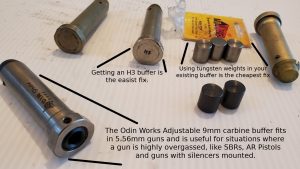
Changing the buffer weight is the most cost-effective, simple and reliable solution I've found for fixing an overgassed AR15. If your AR15 is overgassed, you can simply get a heavier buffer. There are two styles of buffers found in AR15s, the rifle-length and the carbine-length. Carbine-length buffers feature the adjustable/collapsing butt-stock common to modern sporting rifles while the rifle-length buffers are found in the non-adjustable, more traditional stocks.Which Buffer Do I Have?If your buffer is not marked on its face and the rifle is stock, then that means it's a Carbine-Weight buffer. Otherwise, the buffer will have a weight stamp on its face denoting H1, H2 or H3. While you can go out and buy a complete H2 or H3 buffer, it's a bit cheaper to just buy the heavier weights.
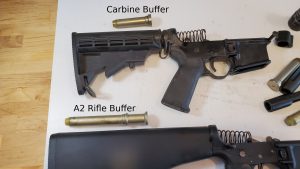
There are four weight classes in carbine buffers, from lightest to heaviest: Carbine (3.0 oz), H1 (3.8 oz), H2 (4.6 oz), and H3 (5.4 oz), with the H being short for heavy. The AR15 carbine buffer has a hollow cavity that is filled with a stack of three weights separated by thin rubber discs. In Carbine-Weight buffers, the three weights inside are steel. In an H1 buffer, one of the three weights is made of a much heavier metal, tungsten. Following this pattern: an H2 has two tungsten and one steel while an H3 buffer has all three weights in tungsten.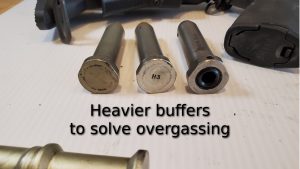
Similarly, rifle-length buffers are hollow and have a weight stack inside. The standard rifle-length buffer weighs about 5.0 oz and has a weight stack of five steel weights and one hollow spacer. However, if you're so inclined, you can take apart the rifle-length buffer and replace some weights with tungsten if you need a heavier buffer.
The Cheap Way
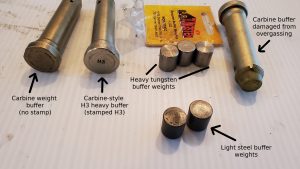
Cheapest Effective Fix: buy tungsten weight set, install in your buffer. If you want to play around with buffer weights and you're handy with tools, just buy a set of three tungsten weights, punch out the retaining pin and pull the hard nylon end cap out and change the weights to suit your needs. It's kind of annoying to punch the retaining pin out and the hard nylon end cap can be hard to pull out, but once you get the right weight you won't want to change it.
You can buy the tungsten weights here.
The Easy Way:
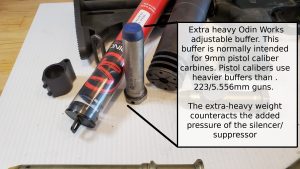
The Odin Works Adustable "9mm" Buffer was perfect for my suppressed & unsuppressed 10.5″ 5.56mm SBR.
For my 10.5″ AR15 SBR (Short Barreled Rifle) that I run with and without a silencer, the easiest solution to getting the perfect buffer weight was the Odin Works Adjustable Buffer. The Odin Works Buffers come in various adjustment ranges from "Lite" (2.1-4.2 oz adjustment range), "Heavy" (3.7-5.8 oz adjustment range) and "9mm" (5.4-7.4 oz). The 9mm version makes it possible to tune from H3 weight up to H4 and even beyond. Odd as it may seem, 9mm pistol-caliber ARs use a heavier buffer weight so they come in the heaviest weight range. Silencers can greatly increase the pressure in the gas system, think of it like stifling a sneeze, so overgassing is a major issue when running a suppressor on an AR15.Because overgassing was such an issue, I ended up taking a chance on using the "9mm" buffer because it's heavier than their "heavy" version. The plan worked, and I now have an AR15 with a 10.5 inch barrel that runs smoothly with and without the suppressor, with no further adjustments needed from me.
IMPORTANT: Be sure to use locktite or a similar thread-locker on the threads of your adjustable buffer because the violent motion of the gun cycling could easily rattle the stopper loose, causing a major gun stoppage. At a match that jam could cost you the day, in a self-defense situation it may cost your life.
Get an Adjustable Buffer Here. - Adjustable Gas Blocks:
- On the surface, an adjustable gas blocks seem like the perfect solution to a rifle with excessive gas pressure. Simply tune the gas block to your ammunition of choice and enjoy a balanced rifle with low recoil and high reliability. Unfortunately, life doesn't always work the way we want it to, and neither do adjustable gas blocks. While there are many people who have had good luck with adjustable gas blocks, I've personally had mixed results using them on the AR15. Due to reliability concerns, they are not my first choice in tuning gas operated firearms.
The problem with adjustable gas blocks will be apparent to anyone experienced in fixing cars or machinery. As any experienced mechanic knows, extreme heat cycles, carbon deposits and the elements all play a role in causing nuts and bolts to rust and seize due to these adverse conditions. Exhaust manifold bolts, turbocharger housing fasteners and other places on a car that are exposed to hot exhaust gasses are prone to corrosion and fouling. In a rifle that is used outside, in high-volume tactical training, multigun competition and other demanding environments, the gas block experiences similar conditions to those of automotive exhaust bolts.
Further complicating matters, adjustable gas block screws are tiny, making it easy to strip threads, round off allen heads and have screws seize in the part. For this reason, those who have the best results with adjustable gas blocks have either bought a few different ones until they found one that works (for now) or they found one setting that works with all of their ammunition and never change the adjustment again.
Use cases where an adjustable gas block may be worthwhile may be high-level three-gun competition where fine-tuning the gas system for the least possible recoil could make a difference in winning a championship, or on a gun that is used rarely and in low volume of fire situations. An example of this may be a precision rifle where the user is creating custom hand loads at atypical pressures and running with and without a suppressor.
In summary, adjustable gas blocks are often close to $100.00 (or higher) and they are failure prone due to the extreme heat and pressure they encounter. Some have good luck with them and those that do tend to set them and then never adjust them again.
- Switch Bolt Carrier Group (BCG):
-
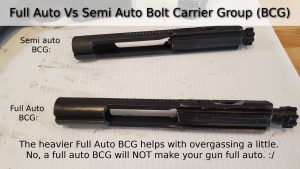
Full Auto vs. Semi Auto BCG
This solution is kind of expensive and offers a small but noticeable change in the bolt carrier group design. There are two BCG designs in standard AR15s: Full-Auto and Semi-Auto. Elephant in the room: no, putting a full-auto BCG in your AR will not make it full auto. The only difference between the full and semi BCG is that the full auto version is a bit heavier, this is by design in that it slows down the rate of fire a little bit. The added weight of the full auto BCG counteracts a bit of overgassing, but not a lot. Since quality BCGs can cost over $100.00 and for safety you need to check the headspace to make sure the bolt face matches up to the firing chamber, this is not my first choice.That said, if your rifle came with a semi auto BCG, you can swap in a full auto version and compensate for a bit of overgassing. Semi auto AR15 rifles often ship with a semi auto BCG, not a full auto BCG. See the accompanying photograph to see which one your rifle has.
Solutions For an Overgassed AR15
I hope you found this article helpful. Join the conversation on Odysee, a censorship-free video platform.
Source: https://specopsgear.com/adjustable-gas-block-vs-buffer-weights/